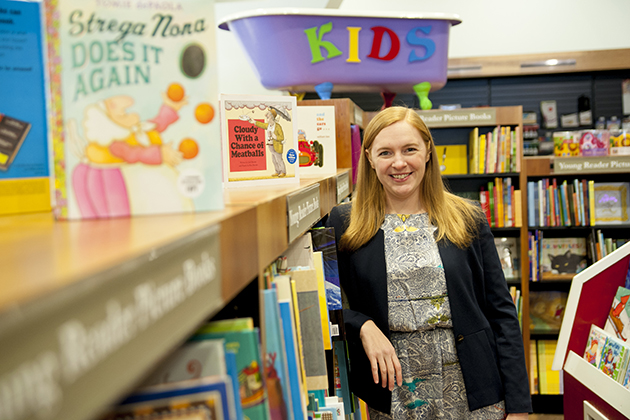
Children’s literature expert Victoria Ford Smith has found an ideal environment in Storrs to teach her specialty.
“This is the first time I’m teaching children’s literature at an institution that has an investment in the genre,” says Smith, an assistant professor of English in the College of Liberal Arts and Sciences. “I’m trying to design my classes to take advantage of these opportunities.”
The opportunities include visiting the Northeast Children’s Literature Collection at the Thomas J. Dodd Research Center; an annual children’s book fair that features contemporary authors and illustrators; and a School of Fine Arts that has majors in illustration and puppetry, as well as the newly expanded Ballard Institute and Museum of Puppetry in Storrs Center.
“We have a critical mass of people who are really invested in this subject,” Smith says. “We have so many events dealing with children’s books. I’m encouraging my students to attend them. It’s exciting.”
Children’s literature in a multimedia world
Teaching children’s literature to college students who have lived in a multimedia world for their entire lives presents both challenges and opportunities, says Smith, who also is a specialist in 19th and 20th-century British literature and culture. Children’s literature today is saturated with media, and many beloved children’s stories are best known through the lens of animation.
“When students know Peter Pan through Disney, they know a pretty scrubbed version,” Smith says. “The characters in J.M. Barrie’s play don’t know if Peter’s adventures are real. In the novelized version, he often went out alone and they never knew whether he had had an adventure because he might have forgotten about it, and they would go outside and find a body. This is a very jarring moment for them. I ask what does Walt Disney’s adaptation of Peter Pan say about how we view childhood now, as opposed to how it was understood in the early 20th century when Peter Pan was popular on the stage? You can’t fight Disney. You have to let him in.”
When students study classic books they have read, however, such as Maurice Sendak’s Where the Wild Things Are, or E.B. White’s Charlotte’s Web, Smith says there is an emotional attachment to the books. She presents the material through a critical lens that can face some resistance, as contemporary cultural and historical views may change the way characters are depicted, such as the representation of Native Americans in Little House on the Prairie by Laura Ingalls Wilder.
“You have to work through that kind of resistance and say [a critical view] does matter, because these are books that are communicating our cultural values to very young readers and it’s good to know the assumptions that underpin them,” Smith says. “For the most part, students are excited to learn about the critical context of the books they think they know so well.”
The emergence of a genre
There is no general agreement on when children’s literature emerged as a genre, according to Smith. While there is an established oral tradition of adults sharing stories and songs with children, some scholars begin tracing the history of children’s literature from 18th-century England, when John Newbery published A Little Pretty Pocket-Book, the first of his successful line of books for children, in 1744. Today, the Newbery Medal is the top prize in children’s literature awarded by the American Library Association.
Smith says earlier literature for children primarily was educational, such as primers, alphabet books, and religious texts. The first picture book for children is considered to be Orbis Pictus, a Latin text published in 1658 by John Amos Comenius, a Czech educator.
“It really kind of ends up being how you define what a children’s book is,”
Smith says seeking a firm starting point for the genre depends on the definition of what a children’s book is. “Is it meant to give a child pleasure reading, or is it something meant to teach them? Can it be both at the same time? I’m biased,” she says, “in that children’s literature as we define it begins in the 19th century as far as how we value imagination and fantasy – it’s the Golden Age of Lewis Carroll (Alice’s Adventure in Wonderland), Edward Lear (A Book of Nonsense, The Owl and the Pussycat), George McDonald (Phantastes), and Edith Nesbit (The Story of the Treasure Seekers). It’s a pivotal moment in its development.”
Children and the creation of stories
Smith’s graduate and doctoral studies at Rice University began in Victorian British literature, but her focus changed after she discovered a document by Barrie, who was reflecting on the five sons of Arthur and Sylvia Llewelyn Davies who became the inspiration for Peter Pan when the author became their guardian following the death of their parents. She became interested in the role of children in the creation of their own literature and culture.
“I’m interested not only in how we value children’s art or how it has been valued as evidence of the child’s imagination and how it should be fostered, but also in evidence from the 19th and early 20th centuries of a child’s art being valued according to its own aesthetic principles – recognizing child artists in a more serious way than we are used to, in galleries and not on refrigerators,” says Smith, who is working on a new book tracing the history of children’s art.
Her first book, Between Generations: The Collaborative Child and Nineteenth-Century Authorship, examines how children collaborate in the creation of stories and can be traced to her interest in how Lloyd Osborne used a toy press to produce the poetry of his step-father, Robert Louis Stevenson, author of Treasure Island. The book was inspired by the boy’s drawing of an imaginary island.
Stevenson is at the top of Smith’s list of those who wrote books for children. She describes him as “a complicated writer,” who had a knack for appropriating popular forms of children’s literature such as adventure stories and changing them in interesting ways. She also enjoys the British author Roald Dahl, who wrote Matilda, because he challenges the notion of stories about playful children by creating characters that may not behave so innocently. Dahl portrays more complex characters who are more closely related to those found in early literature for children, such as Carroll’s Alice: in the original book, she is not always so wonderful. Smith would like to be able to talk more about the complexity of the literature.
“Alice is a collage of many different ideas about childhood, some that we find familiar; some that we find unsettling,” says Smith. “Alice is a brat. She’s not an appealing character. It’s not this tale of whimsy and fantasy and imagination. It’s a critique of drawing room education methods for children. It’s a strange example of Victorian book culture. It’s so much more complicated than this hermetically sealed children’s tale. I wish I had more opportunities to talk about how complex texts that are perceived as very simple really are.”



